The Long March: Promo Retreats From China (Part One)
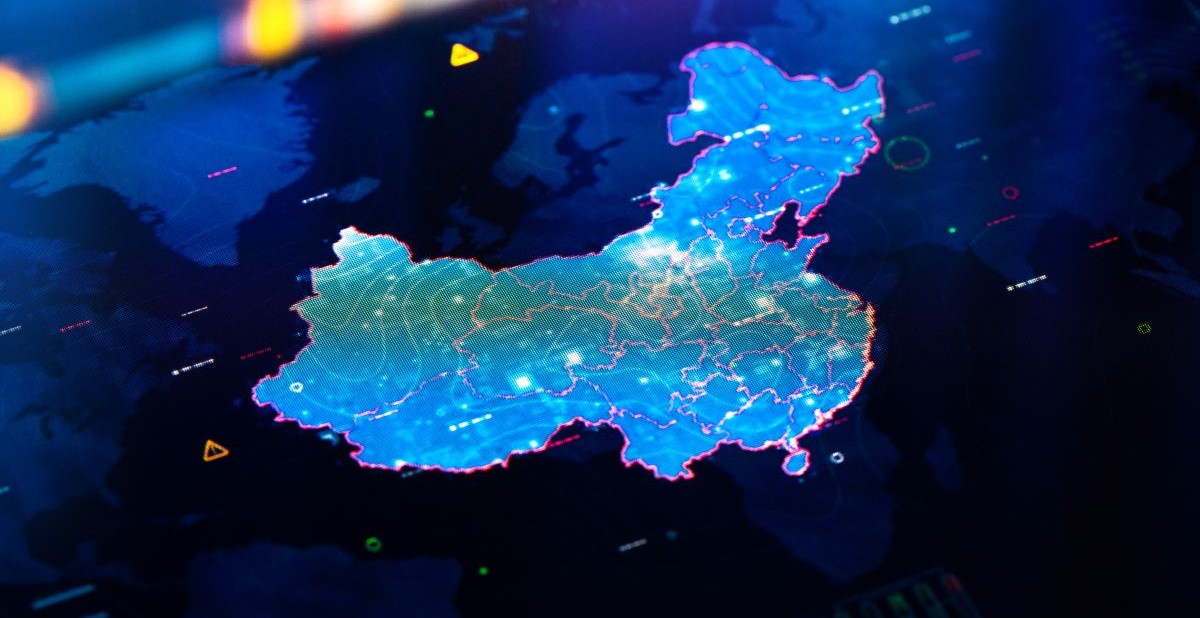
(Editor’s Note: Last spring, PPAI Media profiled the promotional products industry’s complicated relationship with China as it neared a crossroads. In a two-part series updating that story, we examine the industry’s progress at decoupling itself from China, as well as the continued challenges in doing so.)
It’s hard to make branded apparel and bags without cotton. And the cotton has to come from somewhere.
The where has never been of greater importance to the promotional products industry.
Accusations of forced labor used in the production of cotton and other goods and materials in China, particularly in the Xinjiang province, are credible and concerning. Recognizing the human rights implications and its impact on creating a just, equitable supply chain, the promotional products industry has moved quickly to ensure the goods it offers are compliant and responsibly sourced.
Even before the Uyghur Forced Labor Prevention Act (UFLPA) went into effect, the promo community developed deep levels of control and scrutiny to its supply chain and, in many cases, has moved to diversify its sourcing outside of China.
Cotton Concerns
In December 2021, President Biden signed the UFLPA into law. The legislation, which received bipartisan support in Congress, bans imports from China’s Xinjiang Uyghur Autonomous Region (XUAR), under the presumption that all goods from the area are produced with forced labor, and imposes sanctions on foreign individuals responsible for forced labor in the region.
The legislation is a response to evidence showing that the Chinese government has established detention camps for the Uyghur minority population and other Muslim groups in Xinjiang. The law bans imports from the region under the “rebuttable presumption” that forced labor was part of their production. Imports from Xinjiang are only to be allowed into the country if the U.S. government has “clear and convincing evidence” that forced labor was not part of their production.
- Data from U.S. Customs and Border Protection shows that since the UFLPA went into effect on June 21, 2022, through March 3, 2023, the CBP has stopped 3,237 shipments, valued at $961 million. So far, the CBP has denied a total of 424 shipments and released 1,090 shipments into U.S commerce, with the remaining shipments pending a determination.
“In 2022, the XUAR produced roughly 90 percent of China’s cotton, making much of Chinese cotton product exports potentially susceptible to the Uyghur Forced Labor Prevention Act,” says Isaac Stone Fish, founder and CEO of Strategy Risks, a consultancy helping companies manage and reduce their risks doing business in China. “That figure does not include textile products produced outside of Xinjiang with the participation of Uyghur laborers – but the UFLPA applies to such products as well.”
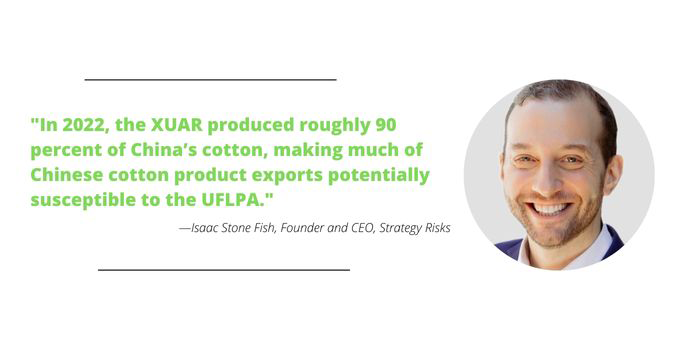
Stone Fish, who spoke last year at PPAI’s Product Responsibility Summit in Newport Beach, California and this June will be joining the PPAI North American Leadership Conference in Washington, D.C., outlined several steps importers can take to reduce the risk of supply chain exposure in Xinjiang. These include:
- Understand and map the cotton supply chain: from field to thread, fabric, and all the way to the finished product.
- Hire the services of companies that specialize in supply-chain analysis to investigate the supply chain for any exposure to Xinjiang, or Uygur labor.
- Some companies provide cotton origin tracing services based on DNA tests. Industry companies can provide samples of the cotton products for testing. However, such tests cannot detect the use of forced labor in the supply chain.
- Make sure that any third-party company hired to investigate a company’s supply chain is based outside of China.
- Keep up to date with the guidelines of U.S. Customs and Border Protection. Avoid working with any companies already identified by the U.S. government as implicated in human rights violations in Xinjiang.
Promo Puts Measures In Place
Fundamentally, the straightforward answer to complying with the UFLPA and ensuring ethical cotton is to source it somewhere other than China. And the evidence shows that there is an openness in the promotional products industry to move production outside of the country. A poll of attendees at the 2022 PPAI Product Responsibility Summit found that 83% of the compliance professionals attending said they were looking to move sourcing elsewhere.
Importers are already cutting back on material brought in from China. What continues to come from the country is under strict scrutiny. Stone Fish notes that any cotton from the Chinese market is running a high risk of containing Xinjiang cotton, or of being manufactured by Uyghur forced labor. But cotton tracing is a highly specialized and difficult process, and even textiles purchased from other countries may be found to have traces of Chinese-grown cotton woven in, doubling the challenge for companies even as they make best efforts for compliance.
“Companies can reduce that risk by having specialists investigate each of their suppliers,” he says. “The specialists can identify high risk suppliers such as known bad actors, companies with indirect exposure to Xinjiang and state-owned companies, among others.
“The risks cannot be eliminated completely. The textile industry in China is extremely exposed to forced labor and other human-rights violations in Xinjiang: As a result, all textile products originating in China run a substantial risk of exposure to Xinjiang cotton and labor.”
Leading industry companies are navigating through the challenges of Chinese cotton sourcing. They are working only with suppliers with which they have long, established relationships; putting new inspection practices in place and transitioning away from the country.
“Several years ago, SanMar dramatically reduced sourcing volumes from China,” says Jeremy Lott, CEO of Issaquah, Washington-headquartered apparel supplier SanMar. “The limited number of products we do source form China are from long-term, trusted suppliers who are leaders in the textile industry. They understand the issue and the risk sourcing from XUAR would pose to their business and they have proven their traceability processes to ensures no inputs are from XUAR.”
Pierre Montaubin, senior vice president of product management and sourcing at Clearwater, Florida-headquartered Koozie Group, which uses cotton in bags and other items, says, “Respect for human rights is a fundamental value of Koozie Group, and we aim to identify and address any risks in our supply chain.
“As best practice in 2020 we made the decision to find alternative sources outside of China for production of cotton goods. As a result, all our cotton products are now being sourced from Bangladesh, Pakistan and India. We use third party audits and supply chain mapping to ensure any cotton we purchase is not sourced from the Xinjiang region of China.”
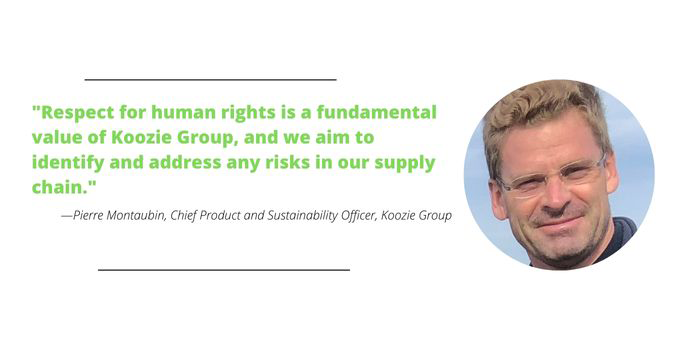
Next Level Apparel, based in Torrance, California, recently announced partnerships with textile manufacturer Grupo M, based in the Dominican Republic, to move its production closer to the North American market, and Oritain to use its cutting-edge forensic science to verify the origin of products and raw materials.
“As part of our commitment to delivering high-quality, responsibly sourced apparel, we work to ensure the integrity of every fabric we use,” says Randy Hales, CEO of Next Level Apparel. “That means we comply with robust sourcing standards that are endorsed by leading associations in the industry, and hold our suppliers to the same high expectations, using isotopic testing as an important safeguarding mechanism.”
In April 2022, New Kensington, Pennsylvania-based Polyconcept North America launched ProudPath, an online platform designed to help distributors navigate social and environmental responsibilities and equip them to be leaders on the issues. The platform both reflects and supports the company’s policies on responsible sourcing.
“At PCNA, we moved 90% of our cotton products outside of China,” says Liz Haesler, PCNA’s chief merchandising officer. “It’s the right thing to do, but it hasn’t been easy. We’ve mostly moved to India and Bangladesh where we can make sure that we’ve got local cotton resources.”
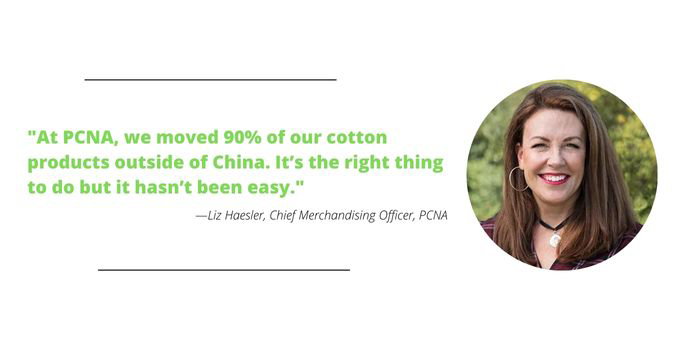
Inspect, Inspect, Inspect
The promotional products industry is devoting considerable time, expertise and effort to ensuring the cotton and other goods that they import are not the product of forced labor and compliant with the UFLPA. Resources and policies are in place at companies across the industry to inspect and analyze what they bring in from overseas.
“We began tracking the cotton issue in 2019, when we were made aware of reports of human rights abuses occurring in XUAR,” Lott says. “Over the next several years, we began a series of supply chain mapping exercises, working closely with our suppliers, to identify where our products are sourced and ensure no finished products or inputs to products are made in XUAR or by entities named on the UFLPA Entity List.”
The inspections and standards extend to the partners and vendors industry companies do business with, as well.
“We do not source cotton directly; therefore, we require all our suppliers to include raw material certifications with each shipment,” Hales says. “Further, we comply with robust sourcing standards that are endorsed by leading associations in the industry, and hold our suppliers to the same high expectations, and use isotopic testing as an important safeguarding mechanism.”
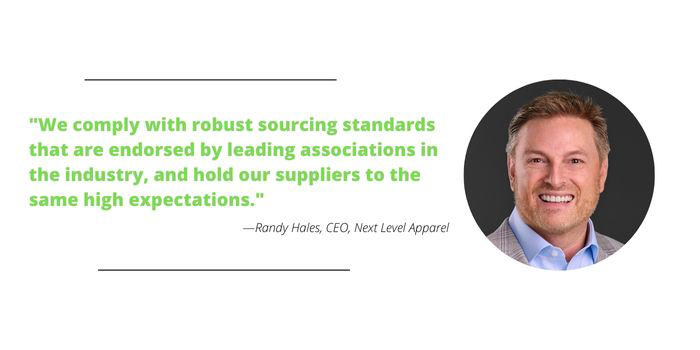
UFPLA bans importation of goods made in whole or in part in the XUAR or by entities on the UFLPA Entity list. PCNA has confirmed that none of its sourcing operations are within regions of question to CBP.
“We have a chain of custody paperwork for all shipments regardless of where it’s made, and upload documents for every shipment to our internal PO management system,” says Haesler. “We are also continuing to hold meetings with suppliers in China and digging deeper into their raw material sourcing operations, not only from a forced labor and responsible sourcing perspective, but also confirm that upstream suppliers are committed to sustainability and can provide evidence of recycled material processing.”
Lessons For Promo
PPAI strives to provide tools to help conduct business ethically and in compliance with the law. The Association has conducted a webinar for more help navigating the cotton supply chain; forced labor and other factors to consider are covered in the comprehensive Guide to Responsible Product Sourcing.
- Several of PPAI’s upcoming conferences, including the 2023 North American Leadership Conference and the 2023 Product Responsibility Summit will examine issues around responsible sourcing and importing goods from China.
The investment in time, effort and money industry companies have put into creating and managing responsible, compliant supply chains have brought lessons as well.
“We believe our global cotton sourcing strategy with our partner suppliers maintains an ethical and compliant position and better aligns with our corporate value,” says Cheron Coleman, vice president of private brand product development and global supply chain at Trevose, Pennsylvania-based supplier alphabroder Prime Line. “We have found many attractive alternatives to China-sourced cotton and will continue to partner with suppliers sourcing verified, ethically sourced raw materials.
Hales says, “Banned cotton is a challenge across the apparel industry that we’ll continue to face until every party truly commits to eliminating these cotton sources from the total supply chain. We encourage those in the industry who are unable to transition to nearshore sources to implement safeguarding measures, such as requiring certifications and testing.”
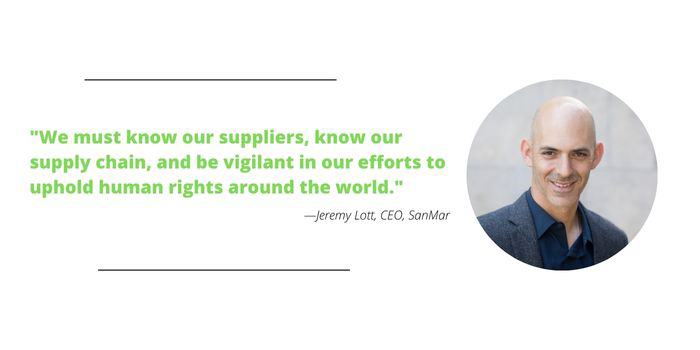
SanMar’s Lott emphasizes that industry companies remain cautious and aware of the issues surrounding China-sourced cotton. He says, “Make sure you are mapping your supply chain and collecting the appropriate documentation to prove where your products were made.
“We must know our suppliers, know our supply chain, and be vigilant in our efforts to uphold human rights around the world.”

